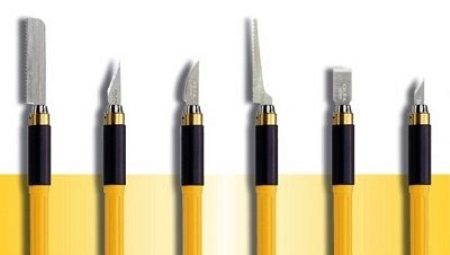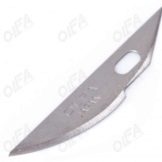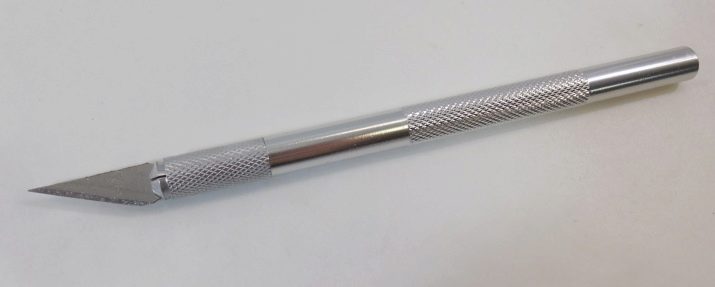Dummy knives: features, selection and methods of use

Model (breadboard) knives stand out noticeably against the background of ordinary tools and differ from them in their properties and functions. Such knives can be used for both office and construction purposes. Most often they are used for cutting and artwork. Such tasks require a very careful and competent approach, which means that the knife must be of high quality, sharp and comfortable. In addition, you need to be able to handle it correctly. In this article, we will pay attention to the breadboard knife, touch on other varieties, talk about their functions and selection features.
Varieties of model knives
Many modelers, especially beginners, often resort to using regular office knives. Skillful hands can do more than just open an envelope or cut a napkin. Simple scissors can also be used. A truly talented modeller is able to create a work of art using available tools. But model knives can greatly simplify the work, making it more convenient and faster.

The first type is a scalpel knife. It is not uncommon for modelers to use surgical scalpels, which can be purchased at the pharmacy, for example. They are made of durable stainless steel and fit very comfortably in the hand. In addition, you can purchase a medical scalpel with a set of interchangeable blades, which can also be used in creativity.


Scalpel knives for wood carving are in the shape of a pencil. They consist of a reliable metal handle and a sharp blade clamped in it. They are convenient for cutting materials of increased hardness and performing work with jewelry precision.With this knife, you can cut, for example, French lace or paper stencils. This variety is more expensive than others, however, it is of higher quality, retains its strength and sharpness longer. Replacement blade kits can always be purchased separately.

The second variety is a cutting knife, also known as a circular cutter. It is sometimes called rotary or just round. It looks like a special pizza knife and works in much the same way. This variety is best suited for working with fabric. With the help of the cutting knife, it can be cut precisely and easily. Also, the tool is able to evenly cut several layers of fabric or paper at once. The circular cutter allows you to make round and long cuts.


Cutting knives differ from each other in their size. When choosing, it is worth considering the scale of the work. There is also a type of circular serrated blade that can be used to cut material in zigzags.

The third variety is breadboard knife. The most common and popular tool among modelers. However, it cannot be called universal. Such knives, like the previous version, can have different sizes, in particular, the width of the blade. The narrow ones are best for fine materials and precision work, while the wide ones are best for something tougher like leather, cardboard, etc.


They can also differ in the material from which they are made. The body can be made of plastic, wood, metal or rubber.
Professional modelers advise not to save money when buying breadboard knives and choose those that contain the least amount of plastic parts. A quality knife will last you better and longer.
An important part of the tool is collet in which replaceable blades are inserted... The plastic clip quickly deteriorates, which is why the blade cannot hold. This, in turn, will negatively affect the results of your work.

The functions of the breadboard knife
A dummy knife is very often used for stationery purposes. But its true purpose is artistic work with light materials. These include:
- paper;
- cardboard;
- thin wood.



Also, a breadboard knife is used in construction to create decor. In the right hands, this instrument is capable of creating real masterpieces. Thanks to its convenience, it allows you to carry out precise jewelry work, such as curved cuts. Therefore, it is impractical to purchase this variety for simple cutting of materials. A simple stationery knife is also suitable for this.

The breadboard knife consists of two main elements - the blade and the handle. We have already talked about the handle, mount and materials for their manufacture above. Now let's take a closer look at the features of the main element, the blade, namely the effect of its shape and size on work. Dummy knives have several varieties, depending on the shape of the cutting part:
- triangular blade;
- rounded blade;
- rectangular blade;
- pointed blade;
- serrated blade.




Each of these varieties has its own specific purpose. An experienced modeler knows when to use the right knives. The same applies to the size and sharpening of the blades. Here are some simple tips from the pros:
- for miniature work, a sharp-pointed blade is suitable, width - 4 mm, edge length - 8 mm, thickness - 0.38 mm, sharpening angle - 30 °;
- universal blade - triangular, width - 6 mm, edge length - 11 mm, thickness - 0.45 mm, sharpening angle - 32.5 °;
- The large blade is 8mm wide, 20mm long, 0.5mm thick, and has a 23 ° sharpening angle and can handle wood and plastic.
By the way, all modern dummy knives provide for the possibility of replacing the blades. They are sold either complete with the instrument itself or separately.So you don't have to limit your creativity and spend a lot of money on it.

What to look for when choosing?
Do not forget that knives differ from each other not only in basic characteristics, but also in workmanship. It depends on the conscientiousness of the seller and the manufacturer of the tool. We have prepared some useful tips for you to follow when choosing. We have already talked about the handle above. Plastic is not the best material for her. But if the plastic is quite strong, then the knife will serve you faithfully for a long time.
Better to play it safe and give preference to a knife with a metal handle.

Convenience is also an important criterion. An additional advantage will be the rubber covering of the handle, which will not allow the knife to slide in the hand during work. The mount consists of a slot in the knob that unscrews like a bottle cap. The desired blade is inserted inside, and the knob is screwed back. Many cheap models of dummy knives have a plastic fastener that breaks quickly, depriving the blade of a reliable fixation. So please note so that the knob is also metal with a rubber coating.

The knife blade must be made of stainless steel. Then, with the correct sharpening, it will serve you for many years. But even if it turned out to be of poor quality, it is easy to replace it with something else. As we mentioned, blade kits can always be purchased separately. Here are a few proven manufacturers that professional modelers often note:
- JAS - specializes in the production of various goods for modelers, including knives;
- Excel - An American company producing goods from the same category is known for a good quality-price ratio;
- Olfa - a Japanese company that produces many different knives, including "art";
- "Zubr" - a domestic knife manufacturer with two models for screen-cutting in its range;
- Hobby Boss - renowned manufacturer of tools for modeling.


Of course, today a large number of online stores allow you to order a knife with delivery anywhere in the world. But the true professional prefers to take a look at the tool first before buying it.
Features of work
To begin with, it's worth mentioning a couple of aids that will come in handy for this job. Safety razor blades are often used by modelers, which are very good at removing unwanted shavings from a bad cut. "Safely" you can process small parts without damaging them. If you're planning to get serious about art cutting, get a mock rug. It will protect the surface of your table from damage. And the knife, when interacting with the rug, does not dull so quickly.

And finally, we have prepared for you some useful tips from experienced modelers:
- the scheme for cutting must be drawn from the back of the material used;
- it is best to start cutting with small parts;
- the contour must be machined last;
- do not skip uncut parts and do not pull them out, otherwise you can ruin the work;
- use a ruler to cut straight lines.

Artistic carving is an ancient form of art. It was practiced by the Slavs, carving out the Russian alphabet, folk symbols, patterns and flowers. For felling, birch bark, wood or leather were used. This hobby remains in demand to this day. The main thing is that anyone can master it. To do this, you only need accuracy and patience.
For more useful information on dummy knives, see the next video.








